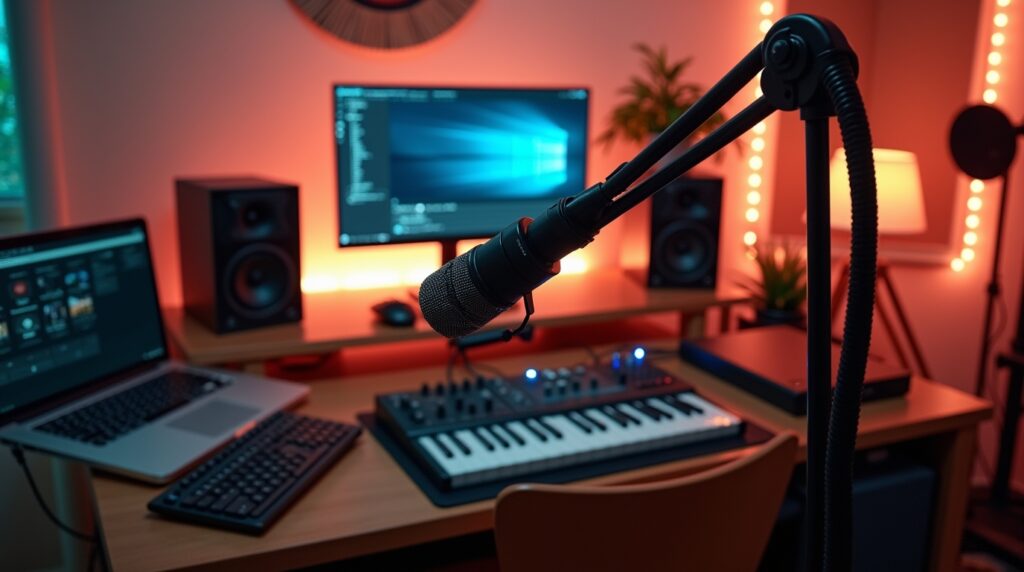Create the perfect setup for quality sound, visuals, and performance in your live streams.
If you’re a musician planning to stream live shows from home, your space matters. In this guide, we’ll show you how to build a stream-ready home studio for musicians—from acoustic treatment and lighting to gear placement and visual appeal. Whether you’re on a budget or going pro, these tips will help you sound and look your best on camera.
Why You Need a Dedicated Home Studio for Streaming
- 🎧 Improved Sound Quality: Acoustic panels, proper mic placement, and an audio interface can drastically improve how you sound to your viewers.
- 🎥 Professional Visuals: Camera angle, lighting, and background aesthetics keep audiences engaged.
- 🎛️ Efficient Workflow: Having everything wired, placed, and ready makes going live faster and less stressful.
- 💡 Brand Consistency: A consistent look and feel helps you stand out and feel like a real performance space.
Key Elements of a Stream-Ready Music Studio
🎙️ 1. Audio Setup
- Microphones: A good condenser mic for vocals (like the Rode NT1 or Audio-Technica AT2020).
- Audio Interface: Essential for clean sound. Popular choices include the Focusrite Scarlett 2i2 or Universal Audio Volt 2.
- Monitoring: Use studio monitors or closed-back headphones to hear exactly what your audience hears.
🎚️ 2. Acoustic Treatment
- Add foam panels, bass traps, and diffusers to reduce echo and improve clarity.
- Carpets, curtains, and bookshelves also help absorb sound naturally.
💻 3. Computer and Streaming Software
- A laptop or desktop with at least 8GB RAM and a solid CPU (i5/i7 or M1/M2 chip) will handle audio and video processing.
- Use OBS Studio (free) or Streamlabs for overlays and multi-cam scenes.
🎥 4. Camera & Lighting
- Use a DSLR, mirrorless, or a quality webcam (like Logitech Brio or Elgato Facecam).
- For lighting, softboxes or LED panels like the Viltrox L116T give flattering, adjustable light.
- Position lights at 45° angles to avoid shadows and give depth.
🖼️ 5. Background & Aesthetics
- Keep your background clean, interesting, and true to your musical style.
- Add instruments, plants, LED strips, or album covers to give personality without clutter.
💡 Want up-to-date gear recommendations? Our 2025 list of top audio interfaces for live streaming music covers reliable options for every budget.
One of the most important choices is your microphone. Here are our top picks for 2025.
Budget vs. Pro Setup Comparison
| Feature | Budget Setup | Pro Setup |
|---|---|---|
| Mic | Fifine K669B (~$40) | Shure SM7B + Cloudlifter (~$500+) |
| Interface | Behringer UMC22 (~$60) | Focusrite Scarlett 2i2 4th Gen (~$200) |
| Camera | Logitech C920 (~$70) | Sony ZV-E10 (~$700) |
| Lighting | Viltrox L116T (~$40/panel) | Elgato Key Light (~$200/panel) |
| Treatment | DIY foam panels (~$60) | GIK Acoustics panels (~$300+) |
| Streaming Software | OBS Studio (Free) | OBS + plugins or Restream Studio (Paid) |
How to Choose the Right Setup for You
- Solo artists: Prioritize clear vocals, camera framing, and a clean background.
- Instrumentalists: Use multiple audio inputs for guitar, keyboard, or loopers.
- Bands: Use mixers, multi-cam setups, and room mics for a natural live sound.
- On a budget? Start small. Good lighting and clean audio can beat high-end gear with bad setup.
Top Picks
🔹 Focusrite Scarlett 2i2 (4th Gen)

- Pros: Great sound, easy setup
- Cons: Only 2 inputs—limited for multi-instrument setups
🔹 Viltrox L116T Bi-Color Panel

- Pros: Soft light, adjustable brightness
- Cons: Battery not included
🔹 Logitech C920 Webcam

- Pros: Reliable full HD video
- Cons: Needs good lighting to shine
🔹 GIK Acoustics 242 Panels

- Pros: Professional absorption and design
- Cons: Higher cost and shipping
FAQ
Yes! With apps like DroidCam or Camo Studio, you can turn your phone into a webcam for OBS.
Not necessarily. Acoustic treatment is more important for clarity than full soundproofing unless you’re in a very noisy environment.
Lighting can make a cheap webcam look great—or make a pro camera look terrible. Always prioritize good lighting.
Final Thoughts
Creating a stream-ready home studio for musicians is one of the best investments you can make for your career or hobby. Whether you’re just starting or going all-in, the right setup will improve your sound, visuals, and connection with your audience. Start with what you have, upgrade gradually, and most importantly—focus on your performance and creativity.
